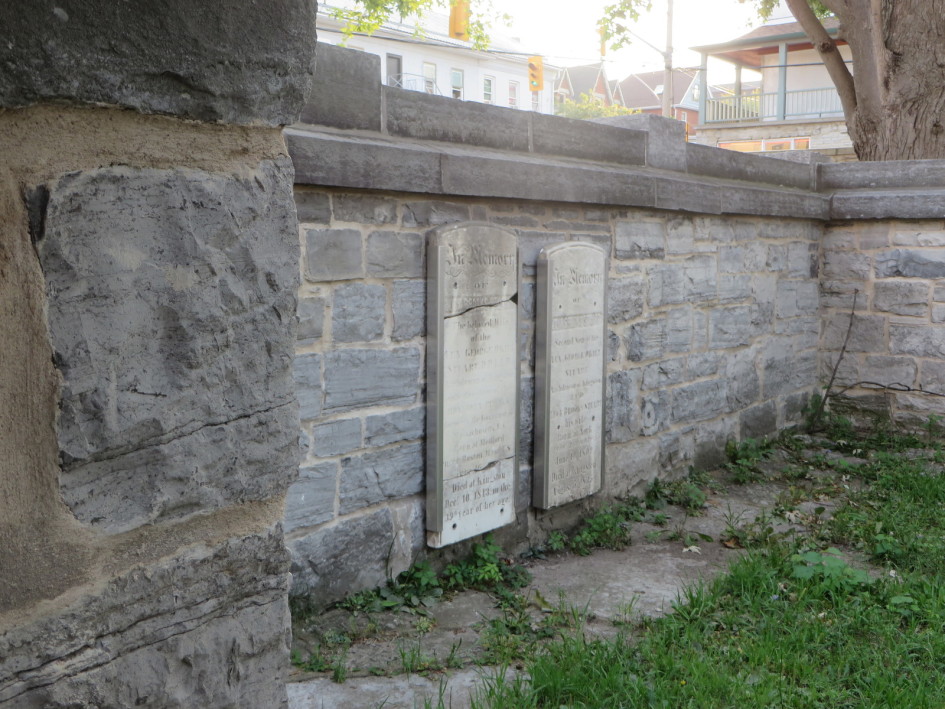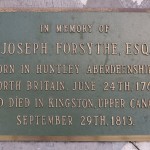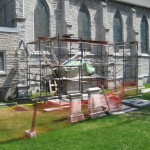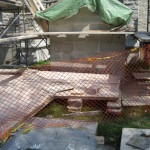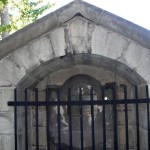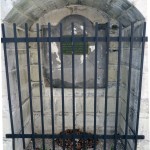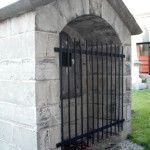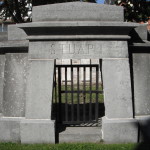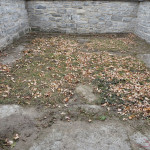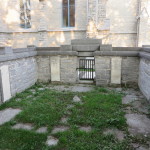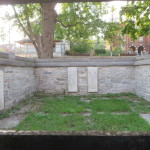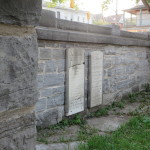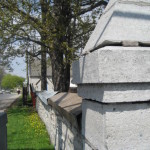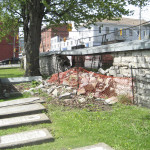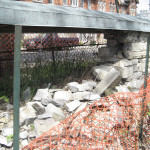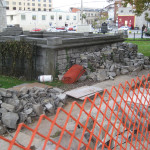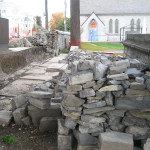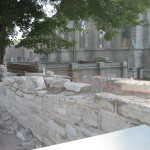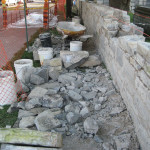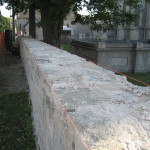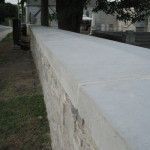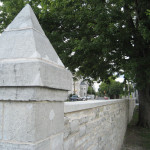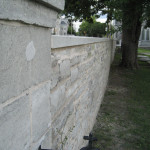Restoration Projects
Forsyth Monument
Joseph Forsyth (c 1764 – 1813) was born in Scotland. A prominent early Kingstonian, he was a victualler for the army, brewery owner, land speculator, forwarder, retailer, justice of the peace, road commissioner, and collector of customs and warden at St. George’s Church.
In 2009, it was discovered that the 1813 Forsyth monument was in danger of immediate collapse. Since it was often used by homeless persons as a place of refuge, its repair was accomplished immediately. The monument or grotto was erected in memory of the Rev. Robert David Cartwright, M.A., on the site of the 1784 burying ground. It is interesting to note that the grotto faces the west wall of St. Paul’s Church which was built later from 1845-47.
The Parish Register of Kingston, Upper Canada, 1785 – 1811, gives this memorable inscription from the larger original plaque which has disappeared:
In memory of Joseph Forsyth, Esq., born in Huntley, Aberdeenshire, North Britain, June 24th, 1764, and died in Kingston, Upper Canada, September 29, 1813.
Blessed by nature with a kind and liberal disposition, he was courteous and engaging in his manners. His ear was ever attentive to the call of distress, and his hand always open to the poor and needy. His memory, endeared to all who knew him, will be cherished as long as any survive of that society of which he was one of the brightest ornaments.
- Forsyth Monument plaque. Forsyth is misspelled.
- Forsyth Monument under restoration
- Forsyth Monument under restoration
- Top of the Forsyth Monument
- Restored Forsyth Monument with protective fence
- Side view of the Forsyth Monument
The Stuart Lair
Jennifer McKendry, in her book Into the Silent Land: Historic Cemeteries & Graveyards in Ontario (2003), states that she believes that the roofless stone enclosure known as the Stuart Lair was likely constructed in the 1840s, possibly to a design by William Coverdale. Coverdale worked closely with George Okill Stuart on the rebuilding of St. George’s Church between 1839- 1842. It is unique in Canada as a piece of cemetery architecture.
The recently-restored walls were hammer dressed with buttresses. Mortar has been replaced, the west rubble wall was dismantled and replaced, and all the walls were repointed. Before restoration, the grave markers, described below, were cracked or broken, some on the ground.
The first member of the Stuart family was the Reverend Doctor John Stuart (1740-1811), the first Anglican missionary in the “Western Settlement” (now Ontario) after the American Revolution.
Others are:
- Mary Stuart Jones (2nd daughter of John & Jane Stuart) wife of Charles Jones (Brockville) (1787-1812)
- Lucy Brooks Stuart (1st wife of Archdeacon George Okill Stuart) (1774-1813)
- Jane Stuart (Eldest daughter of John & Jane Stuart) (1784-1815)
- Mary Rose Ross Stuart (wife of Charles Stuart) (1785-1815)
- Charles Stuart (4th son of John & Jane Stuart) (1782-1816)
- Jane Okill Stuart (wife of John Stuart) (1747-1821)
- John Brooks Stuart (2nd son of Archdeacon George Okill & Lucy Stuart) (1809-1835)
- Charles Stuart, Junior, (Grandson of John & Jane Stuart) (1814-1850)
- Anne Ellis Robinson Stuart (2nd wife of Archdeacon George Okill Stuart) (1785-1856)
and the last one to be buried there
- George Okill Stuart (son of John & Jane Stuart) Archdeacon of Kingston (1776-1862)
- Entrance to Stuart Lair
- Stuart Lair prior to restoration
- Stuart Lair after restoration
- View of Stuart Lair from the entrance
- Stuart Lair with plaques mounted
Lower Burial Ground Wall
A six-foot high dry stone wall with wooden cap was built from October 1800-1808 on three sides of the Lower Burial Ground. The fourth side was already contained with a fence of painted vertical boards (a paling fence) and gate with lock.
In 1853, St George’s Church, which claimed ownership of the Lower Burial Ground throughout the nineteenth century, spent 23 pounds, ten shillings, “repairing the grave yard wall of St Paul’s church”. While the work was not specified, it was probably the re-building of the wall along Montreal Street, since it was about this time that Montreal Street was extended north from Queen Street through what had been the Garrison Garden.
A photograph taken in 1875 shows the wall in excellent condition, constructed of rubble stone set in mortar, while the original was a dry stone wall.
The photograph also shows the new Church Hall, which was erected in 1872. Remarkably, it was built without disturbing the grave stones under it. Most interestingly, the photograph shows a low stone wall along Queen Street, complete with four elaborate stone pillars and a wrought iron railing on top of a stone cap. It remained until 1944 when it was removed because of the cost of repairing it. The pillar on the corner of Queen and Montreal Streets was retained to anchor the Montreal Street wall. At the same time as the demolition of the Queen Street wall, a number of monuments were moved from the area between Queen Street and the Stuart Monument, properly known as a Lair, to an area between it and the Hall. Other monuments that had fallen were laid in concrete beds flat on the ground.
Vibrations from traffic on Queen Street eventually loosened the stones in the rubble-stone and mortar wall and in October of 1936, St. Paul’s Laymen’s Association repaired, repointed and installed three concrete buttresses to strengthen a weak part in the Queen Street wall of the churchyard. This wall occupies the same space as the original and is approximately the same height as the 1800-1808 wall.
Nowadays only the west wall, along present day Montreal Street remains, having been repaired several times, and the stones pointed with mortar. Much of the wall was rebuilt in 2011 and a stone cap was added to the top after a vehicle caused part of the wall to collapse. Below are photos taken during the repair and rebuilding project.
